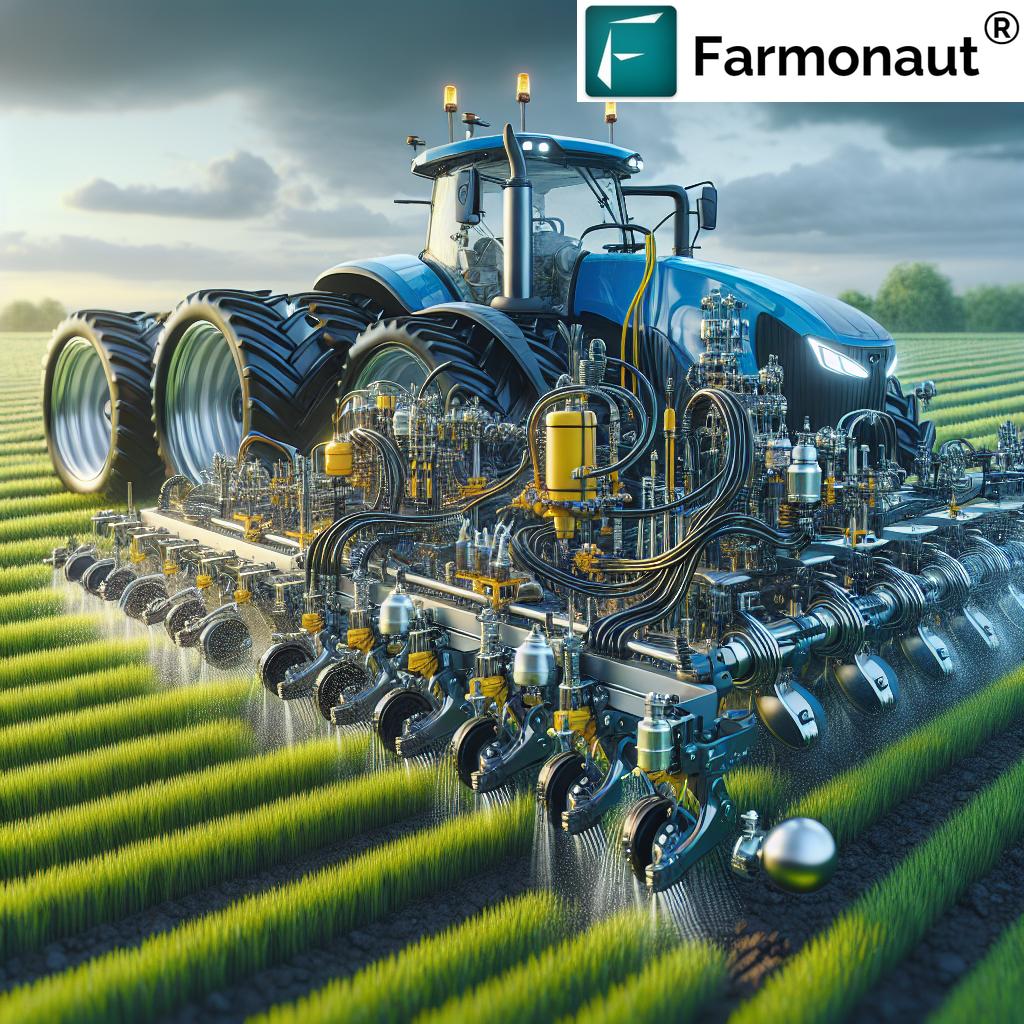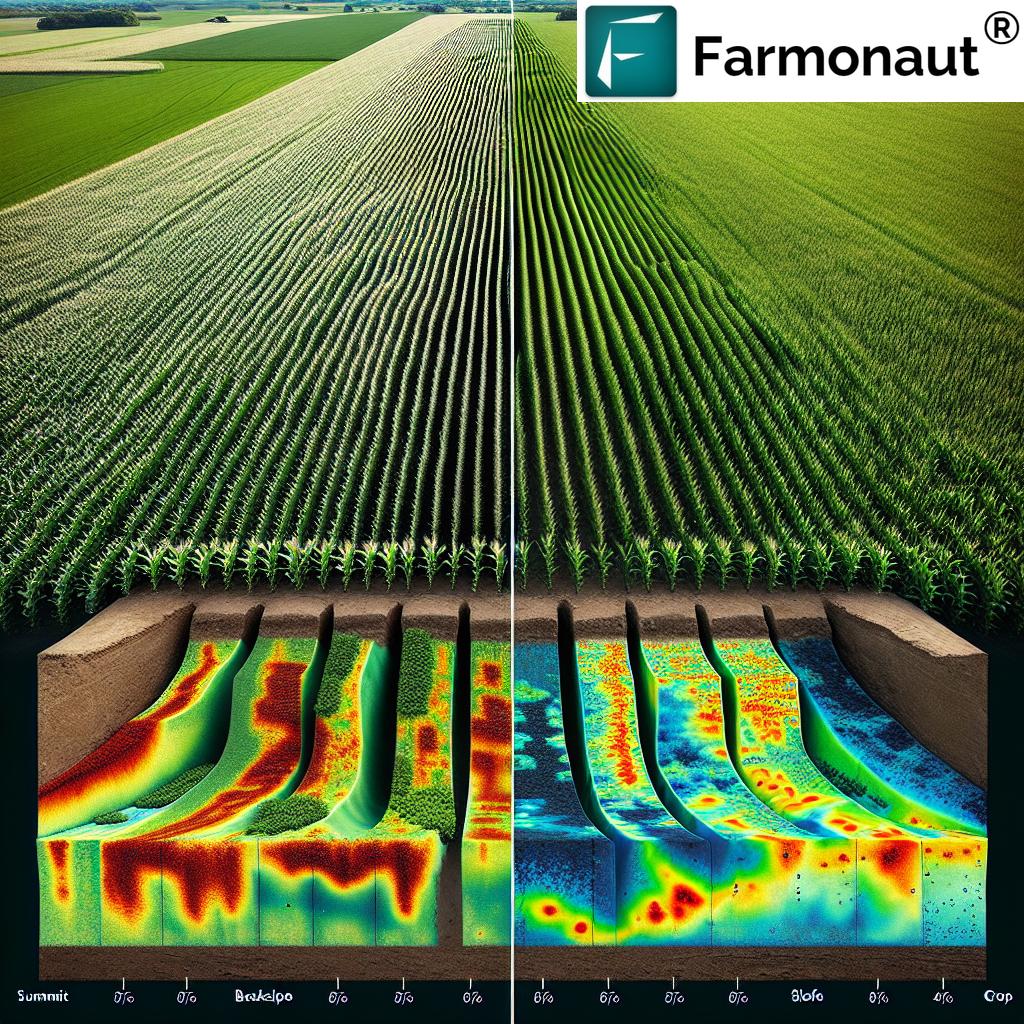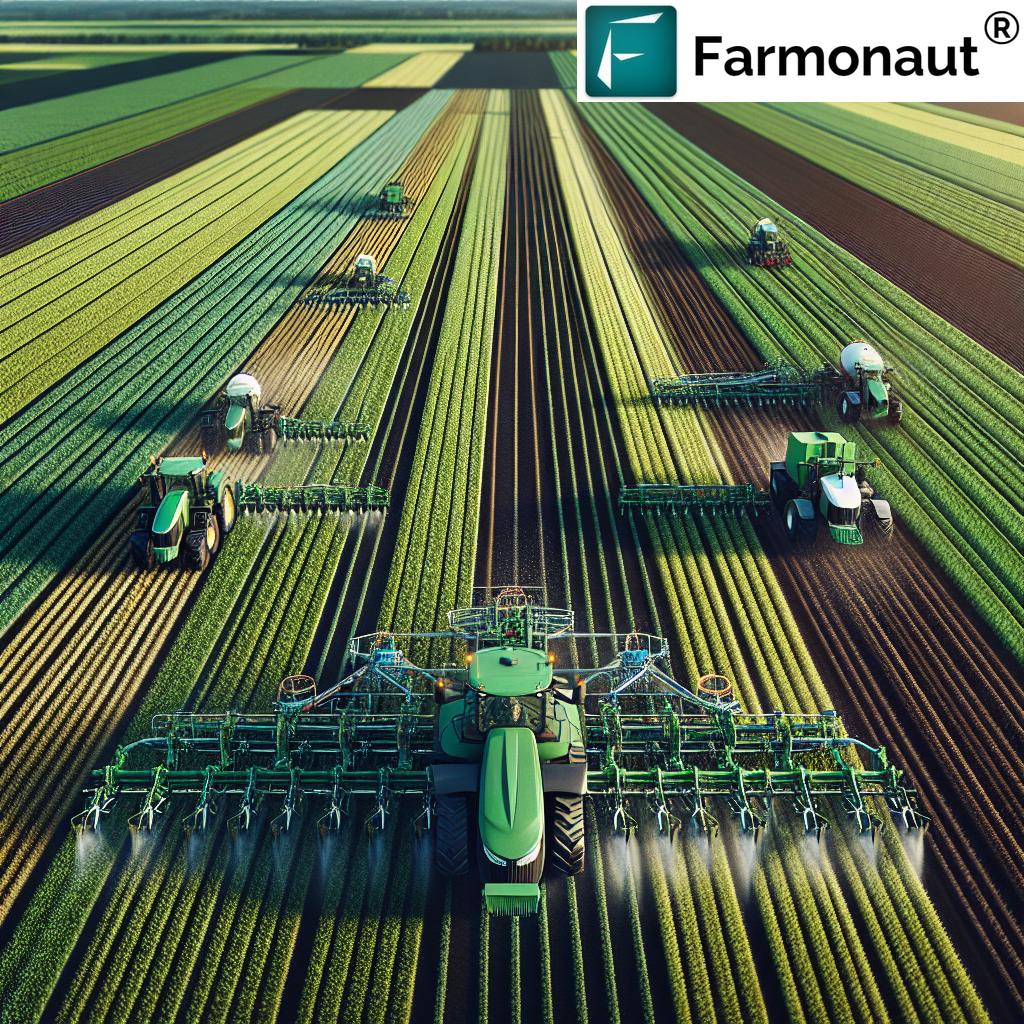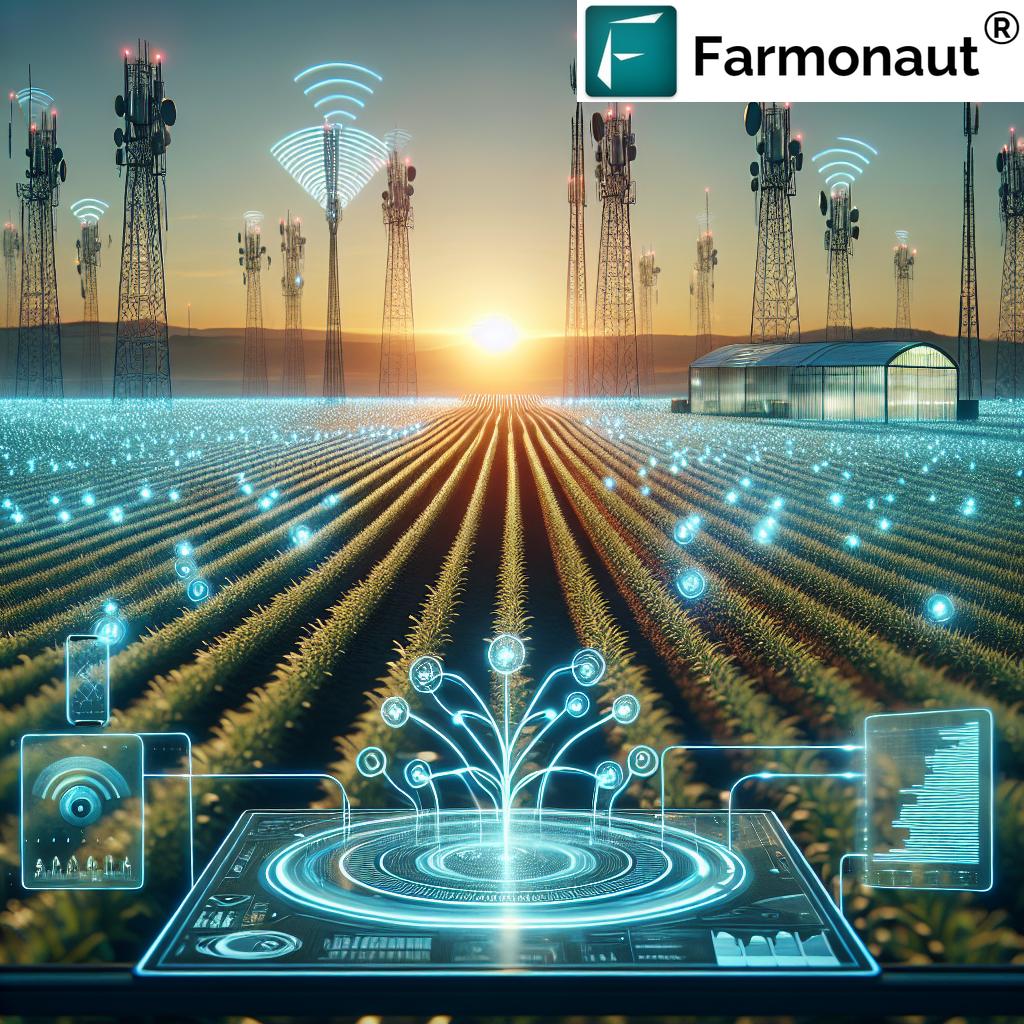AI Agriculture Efficiency 2025: 3 Ways to Boost Yields
“AI-driven soil analysis in 2025 can increase crop yields by up to 20% using predictive insights and smart data integration.”
- Introduction
- The Imperative for AI Agriculture Efficiency in 2025
- How AI is Improving Food Production Efficiency in 2025
- AI Products in Agriculture: Transformative Tools in 2025
- The Role of Agricultural Production Data and Smart Platforms
- 3 Ways of Improving Soil Fertility Using AI Insights
- Comparative Table: 3 AI Methods to Boost Soil Fertility
- Farmonaut: Harnessing AI, Satellite Data, and Blockchain for Agricultural Efficiency
- Farmonaut Subscription Options
- Frequently Asked Questions (FAQ)
- Conclusion
Introduction
The world stands at the threshold of a profound transformation in agriculture. AI agriculture efficiency 2025 is not just a futuristic notion—it’s rapidly becoming the cornerstone of sustainable, efficient, and productive food systems. As global populations continue to rise and environmental challenges intensify, the imperative to enhance food production efficiency has never been greater. By leveraging advanced artificial intelligence (AI), data-driven technologies are optimizing every stage of the agricultural value chain.
This comprehensive guide explores how AI is improving food production efficiency in 2025 through precision analytics, real-time data monitoring, and practical interventions—especially focusing on 3 ways of improving soil fertility that offer tangible, sustainable yield boosts. We’ll examine leading-edge AI products in agriculture, the centrality of agricultural production data, and the integration of satellite, IoT, and blockchain for next-generation farm management. Dive in to discover how these practical strategies are converging to create a resilient, future-ready agricultural system.
“Three AI-powered methods boost soil fertility, improving food production efficiency by 15% in sustainable farming practices.”
The Imperative for AI Agriculture Efficiency 2025
In 2025, the world’s agricultural sector faces immense challenges: surging populations, finite resources, erratic weather patterns due to climate change, and the urgent need to preserve soil health for the long term. Traditional agricultural practices alone are no longer sufficient to achieve the dual goals of increased productivity and sustainability.
AI agriculture efficiency 2025 centers on deploying intelligence-driven tools that analyze vast swathes of data from fields, satellites, and smart sensors—generating predictive insights that allow farmers to make informed decisions in real-time. The result? Enhanced yield, improved soil fertility, and optimized input management—all while minimizing environmental impacts and resource wastage.
Let’s unfold how AI technologies are revolutionizing agriculture in 2025 and beyond.
How AI is Improving Food Production Efficiency in 2025
The integration of AI and machine learning algorithms has become integral to optimizing every step of the agricultural value chain. AI improving food production efficiency in 2025 involves the advanced analysis of satellite imagery, sensor data, weather forecasts, and agricultural production data to deliver:
- Precision Agriculture: AI-powered systems tailor inputs—like water, fertilizers, and pesticides—to the exact needs of crops, minimizing waste and maximizing yield.
- Targeted Pest Management: AI analyzes crop images from drones and sensors to detect pest infestations early, enabling localized, targeted treatments—reducing chemical use and preventing infestations from becoming epidemics.
- Real-time Monitoring: Smart sensors in fields track soil moisture, microclimate variations, and nutrient levels, feeding data into AI systems that issue actionable recommendations for irrigation and fertilization.
- Yield Forecasting: Machine learning models use historical and real-time data to predict yield outcomes, helping farmers plan harvests, manage post-harvest logistics, and optimize their value chain.
One prominent example is the use of AI-powered drones and autonomous machinery to monitor crop conditions, identify pest issues, and apply treatments only where necessary. This approach not only boosts production efficiency but also reduces costs and fosters sustainable farming practices for long-term food security.
As we transition deeper into 2025, the cumulative effect of these AI-driven practices is evident—farms are seeing higher yields, better resource management, and more resilient production systems capable of adapting to ever-changing environmental conditions.
AI Products in Agriculture: Transformative Tools in 2025
The rise of AI products in agriculture is transforming traditional food production systems. In 2025, modern farmers utilize a suite of AI-empowered tools designed to enhance every facet of the agricultural value chain:
Key AI Products Improving Food Production Efficiency 2025
-
Smart Soil Sensors:
- Embedded directly into fields, these sensors monitor soil moisture, nutrient content, and organic matter in real time.
- AI platforms analyze this data to adjust irrigation schedules and recommend precise fertilization plans.
-
Satellite-Based Monitoring Platforms:
- Satellite imagery coupled with AI delivers high-resolution, field-level insights on vegetation health, soil conditions, and even early disease detection.
-
Predictive Disease and Pest Detection:
- Platforms integrating IoT and AI analyze weather data, crop phenology, and local outbreaks to forecast disease or pest invasions before they become devastating.
-
Autonomous Machinery:
- Drones and robots perform field scouting, spraying, and targeted application of treatments with unmatched precision, reducing both input costs and environmental impact.
-
Supply Chain AI:
- AI-driven logistics platforms optimize post-harvest handling and routing, helping reduce losses and ensure that food products reach markets efficiently and on schedule.
Such AI products in agriculture not only empower farmers to respond to today’s challenges but equip them for the future—offering tools for resilient, data-driven farming that keeps pace with changing global conditions.
For detailed real-time tracking of soil health, environmental impact, and optimizing agricultural management using satellite data and AI, explore our Carbon Footprinting Platform. This service empowers farms to manage their environmental responsibility while boosting productivity.
The Critical Role of Agricultural Production Data and Smart Platforms
Behind every successful AI system in agriculture lies a foundation of accurate, extensive agricultural production data. This includes:
- Soil composition and nutrient profiles.
- Weather patterns and historical rainfall data.
- Crop growth stages and phenological data.
- Yield results year over year.
- Real-time field conditions from sensors.
AI platforms analyze this data to produce predictive models—guiding strategic decisions like planting times, crop selection, crop rotations, and resource allocation. This data aggregation is further enhanced by cloud-based solutions and mobile app interfaces—bringing actionable intelligence to even the smallest of farms.
For next-level field and resource management using AI and production data, our Large Scale Farm Management Platform offers real-time operational intelligence, remote field monitoring, and actionable insights—the smarter way to manage big farms in 2025.
3 Ways of Improving Soil Fertility Using AI Insights
The capacity to sustainably increase yields and maintain resilient production systems hinges on one critical factor: soil fertility. In 2025, AI offers transformative, data-driven methods to improve soil health and fertility, each with distinct benefits for farmers and the environment.
1. Precision Nutrient Management
By leveraging AI-based analysis of soil nutrient profiles and historic crop requirements:
- Optimal fertilizer application is enabled, delivering precise types and amounts according to the needs of each field sector.
- This reduces over-application, prevents soil degradation, avoids runoff, and cuts unnecessary costs.
- The result? Yield boosts of up to 18–20% and lasting improvements to soil health.
Such precision is only possible through advanced analytics and real-time AI recommendations, tailored to local production data.
2. Crop Rotation and Cover Cropping Optimization
Using historical data, weather patterns, and AI algorithms, farmers can:
- Determine the most beneficial crop sequences and select cover crops that enhance organic matter and disrupt pest cycles.
- This boosts soil structure and microbial health, increasing water retention and nutrient availability.
- Yields can rise by 10–15% thanks to biologically richer soils and reduced pest pressure.
Such data-driven planning was never possible at scale until the era of AI agriculture efficiency 2025.
3. Soil Health Monitoring and Remediation
Smart, AI-powered sensors now detect early signs of soil compaction, erosion, or chemical contamination:
- Proactive interventions like aeration, bioremediation, or organic amendments can be applied exactly where—and when—they’re needed.
- This preserves long-term soil productivity while reducing the need for costly restorative works later.
- Overall efficiency and food production can improve by up to 12–16% using these real-time insights and interventions.
Comparative Table: 3 AI Methods to Boost Soil Fertility (2025 Outlook)
| AI Method | How It Works | Estimated Yield Increase (2025) | Additional Benefits |
|---|---|---|---|
| Smart Soil Monitoring | Continuous AI-powered sensor analysis tracks moisture, nutrients, and conditions; automates targeted interventions. | +18–20% | Cuts input costs; prevents over-fertilization; reduces environmental impact; sustains soil health. |
| Predictive Fertilizer Application | AI analyzes production data for nutrient deficiencies, prescribes exact fertilizer types, rates, and timing. | +15–18% | Maximizes yield; prevents waste; improves soil structure and microbial activity. |
| Automated Crop Health Analysis | Drones and satellite platforms deploy AI for early pest, disease, and stress detection—enabling targeted care. | +10–16% | Enhances resilience; avoids widespread crop loss; fosters sustainable practices. |
Trace soil-to-table authenticity and transparency in every step of your agricultural value chain using our Blockchain-Based Traceability Platform. Promote trust and provenance with AI-enhanced traceability in 2025.
Farmonaut: Harnessing AI, Satellite Data, and Blockchain for Agricultural Efficiency
At Farmonaut, we understand that the future of farming hinges on precision, intelligence, and sustainability. Our mission is to democratize satellite-driven insights and make disruptive agri-tech affordable for farmers, business decision-makers, and government agencies around the world.
What distinguishes our platform?
- Advanced Technologies: We blend satellite imagery, artificial intelligence, blockchain, and machine learning to deliver the full power of modern agri-data. Multispectral imaging uncovers hidden insights into soil health, crop vigor, and field conditions.
- Jeevn AI Advisory System: Our proprietary AI engine delivers real-time agronomic advice, tailored crop management strategies, and actionable weather intelligence—delivering precise, sustainable productivity gains at every stage.
- Blockchain Traceability: Blockchain technology assures end-to-end transparency and security in the agricultural supply chain, enhancing both trust and market value.
- Environmental Impact Tracking: Tools for tracking carbon footprint and compliance, enabling farms to align with global sustainability mandates and unlock climate-smart financing.
- Scalable Platforms: Whether you’re an individual farmer, enterprise manager, or government policymaker, Farmonaut’s modular platform scales with your operational needs.
- Accessible Everywhere: Operate from the field or remotely via Android, iOS, and web apps, or integrate our agricultural intelligence directly via enterprise APIs.
By converging these elements in a user-friendly ecosystem, we are propelling global agriculture towards greater efficiency, productive resilience, and real sustainability.
Empower your farm or agribusiness with AI.
Expand your own agri-tech solutions via Farmonaut’s API endpoint or reference the API Docs for rapid implementation.
Streamline agricultural lending and insurance with trusted, satellite-based field verification through our Crop Loan and Insurance Solutions—transforming risk management in 2025.
Maximize operational efficiency and control with advanced satellite and AI-based Fleet Management Solutions for the agriculture sector—monitor machinery, ensure safety, and lower operational costs.
Farmonaut Subscription Options
Ready to take your food production efficiency to the next level? Our subscription packages are tailored for farms and agribusinesses of every size, delivering cutting-edge AI, satellite, and analytics capabilities at flexible, affordable tiers.
Frequently Asked Questions (FAQ)
-
Q: What is meant by “AI improving food production efficiency 2025”?
A: This refers to the dramatic impact of artificial intelligence in optimizing the entire agricultural production process. In 2025, AI leverages advanced data from satellites, sensors, and historical production data to help farmers make real-time, precise decisions—leading to higher yields, reduced input costs, and greater sustainability. -
Q: How does AI increase soil fertility?
A: AI analyzes soil conditions, predicts nutrient deficiencies, recommends precise fertilizer applications, and even identifies optimal crop rotation schedules. Real-time monitoring also detects early issues in soil health, allowing for targeted interventions that maintain fertility long-term. -
Q: What are the most effective AI products in agriculture for 2025?
A: Key AI-driven products include smart soil sensors, AI platforms for crop health and pest monitoring, satellite-based environmental monitoring, blockchain-enabled traceability, and logistics optimization systems that reduce losses and enhance efficiency. -
Q: How can smallholders access these AI innovations?
A: Cloud-based and mobile app platforms—like those offered by Farmonaut—make AI-powered agricultural production data, insights, and recommendations affordable and accessible to even small-scale farmers, ensuring widespread adoption and impact. -
Q: How does satellite technology contribute to AI agriculture efficiency?
A: Satellites provide high-resolution, multispectral data on vegetation health, soil properties, crop stress, and weather conditions. AI processes this data to offer focused, actionable advice that boosts yields, resource efficiency, and sustainability. -
Q: Is AI useful for sustainable and climate-smart agriculture?
A: Yes. AI platforms can track environmental impacts like carbon emissions, optimize fertilizer and water use, and enable successful regenerative agriculture practices—ensuring that future food systems are resilient and sustainable.
Conclusion
By 2025, AI will be the driver accelerating agriculture towards greater efficiency and sustainability. From advanced soil monitoring to predictive intervention and blockchain traceability, the integration of AI, satellite, and smart data platforms enables farmers around the world to boost yield, protect soil fertility, and future-proof their operations.
As we embrace the era of AI agriculture efficiency 2025, continuous innovation, data-driven insights, and practical strategies—such as the 3 ways of improving soil fertility—will ensure our global food system remains abundant, sustainable, and resilient. By leveraging the latest AI products in agriculture and maximizing the value of agricultural production data, every farm—regardless of scale—can secure its place in the agricultural revolution.
Explore how AI is improving food production efficiency today with Farmonaut, and join us on the journey towards a smarter, more productive, and environmentally responsible agricultural future.












